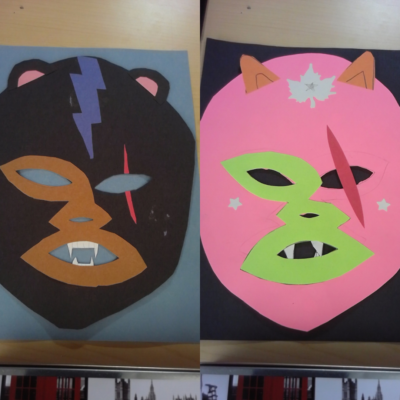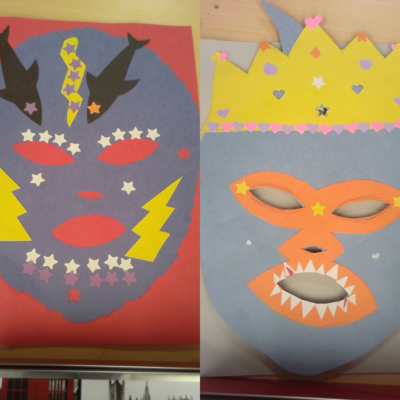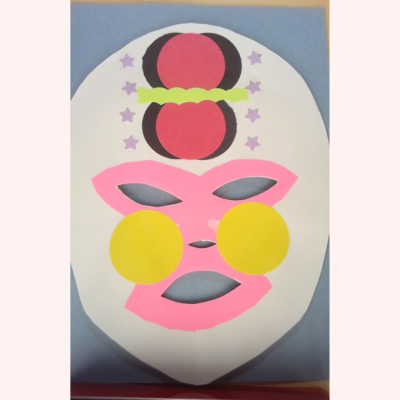Create your own Lucha Libre Luchador:
How a Media, Art and Spanish teacher used project-based learning in their classroom
After hearing about this awesome interdisciplinary project I just had to share! I reached out to Joelle Kilcourse, Library Media Specialist for grades k-5 at Riverfield School in Fairfield Connecticut, to get all the details.
Jenny: How did you come up with the idea for this 3rd grade integrated project?
Joelle: For the last few years, Riverfield School has participated in the Global Read Aloud. This year, the picture book study focused on the work of Mexican author-illustrator Yuyi Morales. After reading the books, I approached Marta Mwambulukutu, our Spanish teacher, and Bob Matarazzo, our Art teacher, to work on creating a PBL experience for our students that we shared. We talked as a team and decided that creating Lucha Libre masks inspired by the book Nino Wrestles the World would be a great way to connect art, spanish, and library-media. Together we made a timeline for the assignment for our three classes-which included a luchador mask with an identity, whose story students would capture in a picture book. Bob incorporated elements into his class that highlighted the spanish words for animals and colors; Marta created some sentence starters for vocabulary and incorporated them into her Spanish lessons; and in library time I focused on teaching students about Mexican culture, the roots of Lucha Libre wrestling (we had a guest speaker even come in to give an incredible presentation!) and, later I covered the technology skills necessary for publishing their final work. We also aligned the work with our standards to ensure student work was meaningful. Student masks and their explanations (written in english and spanish) were exhibited in our district’s art show in the spring.
Jenny: Wow, kudos to you three-these are three content areas that don’t commonly dive into PBL; in particular world language. Can you tell me a bit more about how the spanish teacher used project based learning in their classroom?
Joelle: She was focusing on vocabulary for “the community and where I live”. She created the sentence frames below based on this vocabulary. That vocabulary integrated into the mask project because students took on the persona of their Luchador mask~using creativity and what they understood in Spanish to add to their persona of the Luchador identity.
Jenny: Tell me more about your guest speaker and the role they played in this project
Joelle: Yes, Mike Fonseca was great-he is a sports agent who represents Cain Velasquez the Mexican-American professional wrestler. Marta (Spanish teacher) remembered that Mike had a background in sports management and grew up in Mexico. We sent an email to share about the project and asked him to come in and talk to kids about his work with Cain, WWE and Lucha Libre-and wrestling as touchstone of Mexico’s culture. We shared our goals for the kids and he put together at Power Point-he focused on Lucha Libre and the role of a mask. He answered a ton of questions for the kids-they loved it.
Jenny: What were some of the benefits to this project?
Joelle: It was really fun for our students to work on something special in their “specials” classes. We often try to connect “specials” classes to Language Arts, Math, Science, and Social Studies, but I think this project reinforced the notion that Art, World Language, and Library-Media have depth and value in different and exciting ways. The picture books were absolutely perfect for grade 3 and students were engaged and interested by the project. Also, the classroom teachers were totally supportive and flexible.
Jenny: I’m so glad you were able to showcase the value of these “specials” for students! What did the teachers do to show their support of your project? What was helpful or what could have enhanced the project even more?
Joelle: They gave us time! For example, when our guest speaker came he saw the whole grade at once. They also gave up extra time; for example I needed to teach the students Google Apps for Education to create their projects-which was a skill that benefited all of our content areas-so they were happy to do it!
Jenny: What were some of the “deltas” to this project, if you were to do it again?
Joelle: Because we are on a 6 day rotation, everything takes longer than we plan! Marta and Bob are long finished with their work on this project, but I am still working on the publishing piece. We are pretty much finished though– just proofing and editing now! We also plan on incorporating a metacognitive piece that will allow students the opportunity to reflect on the project as a whole, their strengths, weaknesses, and interests moving forward.
Jenny: Oh I love this metacognitive piece-tell me more about your future vision for this!
Joelle: Well this is actually our goal for next year! We want to share this across the district and this is the piece we will build out. The Spanish curriculum and Art really focuses on presentation skills so this will also help with that. As a learner to reflect upon this entire experience I think will really help them with empathy as well-learning about other cultures and seeing yourself as a global citizen.
Jenny: What did assessment look like for this project?
Joelle: We were unable to assess this together because of our schedules, so we each used our own criteria for assessment. We would like to do this again next year, and we have already begun working on single a standards-aligned rubric that we will each use to assess our content.
Jenny: What advice would you give to other Library Media Specialists who are thinking about PBL? Or teachers in general?
Joelle: Do IT! Just jump in! Expect your timeline will shift-don’t let that prevent you from doing it because the outcome and the learning is so powerful that it makes it all worth it!
Thanks to Joelle for sharing this great project with me! If you want to follow along to continue to watch how a Media, Art and Spanish teacher use project-based learning in their classroom check them out on Twitter @RiverfieldLLC.
Resources:
My GRA Google Slide Presentation
Student sample luchador sentences
Standards Covered:
Library-Media AASL Standards
I.D.1-4: Learners participate in an on-going inquiry-based process by:
- Continually seeking knowledge.
- Engaging in sustained inquiry.
- Enacting new understanding through real-world connections.
- Using reflection to guide informed decisions.
III.D.1-2: Learners actively participate with others in learning situations by:
- Actively contributing to group discussions.
- Recognizing learning as a social responsibility.
V.A.1-2: Learners develop and satisfy personal curiosity by:
- Reading widely and deeply in multiple formats and write and create for a variety of purposes.
- Reflecting and questioning assumptions and possible misconceptions.
VI.C.2: Learners responsibly, ethically, and legally share new information with a global community by:
- Disseminating new knowledge through means appropriate for the intended audience.
VI.D.1: Learners engage with information to extend personal learning by:
- Personalizing their use of information and information technologies.
World Language
These are the standards from the “World-Readiness Standards for Learning Languages” put out by the American Council on the Teaching of Foreign Languages (ACTFL).
- Making Connections: Learners build, reinforce, and expand their knowledge of other disciplines while using the language to develop critical thinking and to solve problems creatively.
- Presentational Communication: Learners present information, concepts, and ideas to inform, explain, persuade, and narrate on a variety of topics using appropriate media and adapting to various audiences of listeners, readers, or viewers.
- Relating Cultural Products to Perspectives: Learners use the language to investigate, explain, and reflect on the relationship between the products and perspectives of the cultures studied.
Art
National Core Arts Standards
- Anchor Standard 1: Generate and conceptualize artistic ideas and work.
Enduring Understanding: Creativity and innovative thinking are essential life skills that can be developed.
3rd: VA:Cr1-1.3a: Elaborate on an imaginative idea.
Enduring Understanding: Artists and designers shape artistic investigations, following or breaking with traditions in pursuit of creative artmaking goals.
Essential Question(s): How does knowing the contexts histories, and traditions of art forms help us create works of art and design? Why do artists follow or break from established traditions? How do artists determine what resources and criteria are needed to formulate artistic investigations?
3rd: VA: Cr1.2.3a
- Anchor Standard 11: Relate artistic ideas and works with societal, cultural, and historical context to deepen understanding
Enduring Understanding: People develop ideas and understandings of society, culture, and history through their interactions with and analysis of art.
Essential Question(s): How does art help us understand the lives of people of different times, places, and cultures? How is art used to impact the views of a society? How does art preserve aspects of life?
3rd: VA: Cn11.1.3a



